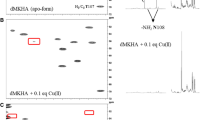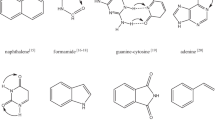Abstract
3-Nitrotyrosine (Nit) belongs to products of oxidative stress and could probably influence conformation of neurodegenerative proteins. Syntheses of peptides require availability of suitable synthon for introduction of Nit residue. Common phenolic protection groups are more acid labile, when they are attached to Nit residue. We have found that Fmoc–Nit(Bn)–OH is a good building block for syntheses of Nit containing peptides by Fmoc/tBu strategy. Interestingly, the peptides containing multiple Nit residues can be available solely by use of Fmoc–Nit(Bn)–OH synthon. Bn is removed rapidly with ca 80 % trifluoroacetic acid in dark. The cleavage of Bn from Fmoc–Nit(Bn)–OH proceeds via pseudo-first order mechanism with activation barrier 32 kcal mol−1 and rate k = 15.3 s−1 at 20 °C. This rate is more than 2,000,000 times faster than that for cleavage of benzyl from Tyr(Bn).






Similar content being viewed by others
Change history
25 October 2019
This errata is for paper ���Rapid acidolysis of benzyl group as a suitable approach for syntheses
25 October 2019
This errata is for paper ���Rapid acidolysis of benzyl group as a suitable approach for syntheses
References
Abe K, Pan LH, Watanabe M, Kato T, Itoyama Y (1995) Induction of nitrotyrosine-like immunoreactivity in the lower motor neuron of amyotrophic lateral sclerosis. Neurosci Lett 199(2):152–154
Aceña JL, Sorochinsky AE, Soloshonok V (2014) Asymmetric synthesis of α-amino acids via homologation of Ni(II) complexes of glycine Schiff bases. Part 3: Michael addition reactions and miscellaneous transformations. Amino Acids 46(9):2047–2073
Adamson JG, Blaskovich MA, Groenevelt H, Lajoie GA (1991) Simple and convenient synthesis of tert-butyl ethers of Fmoc-serine, Fmoc-threonine, and Fmoc-tyrosine. J Org Chem 56(10):3447–3449
Allouche AR (2011) Gabedit—a graphical user interface for computational chemistry softwares. J Comput Chem 32:174–182
Barlos K, Gatos D, Koutsogianni S, Schafer W, Stavropoulos G, Wenging Y (1991) Darstellung und einsatz von N–Fmoc–O–Trt–hydroxyaminosäuren zur “solid phase” synthese von peptiden. Tetrahedron Lett 32(4):471–474
Barone V, Cossi M (1998) Quantum calculation of molecular energies and energy gradients in solution by a conductor solvent model. J Phys Chem A 102(11):1995–2001
Bartesaghi S, Wenzel J, Trujillo M, López M, Joseph J, Kalyanaraman B, Radi R (2010) Lipid peroxyl radicals mediate tyrosine dimerization and nitration in membranes. Chem Res Toxicol 23(4):821–835
Beal MF, Ferrante RJ, Browne SE, Matthews RT, Kowall NW, Brown RH Jr (1997) Increased 3-nitrotyrosine in both sporadic and familial amyotrophic lateral sclerosis. Ann Neurol 42(4):644–654
Becke AD (1993) Density-functional thermochemistry. III. The role of exact exchange. J Chem Phys 98(7):5648–5652
Beyerman HC, Bontekoe JS (1962) The t-butoxy group, a novel hydroxyl-protecting group for use in peptide synthesis with hydroxy-amino acids. Recl Trav Chim Pays-Bas 81:691–698
Bodanszky M, Bodanszky A (1994) The practice of peptide synthesis. Springer, Berlin, p 48
Butterfield DA, Reed T, Sultana R (2011) Roles of 3-nitrotyrosine- and 4-hydroxynonenal-modified brain proteins in the progression and pathogenesis of Alzheimer’s disease. Free Radic Res 45(1):59–72
Carpino LA, Han GY (1972) The 9-fluorenylmethoxycarbonyl amino-protecting group. J Org Chem 37(22):3404–3409
Cossi M, Rega N, Scalmani G, Barone V (2003) Energies, structures, and electronic properties of molecules in solution with the C-PCM solvation model. J Comp Chem 24(6):669–681
Dear DV, Kazlauskaite J, Meersman F, Oxley D, Webster J, Pinheiro TJT, Gill AC, Bronstein I, Lowe CR (2007) Effects of post-translational modifications on prion protein aggregation and the propagation of scrapie-like characteristics in vitro. Biochim Biophys Acta 1774(7):792–802
Erickson BW, Merrifield RB (1973) Use of chlorinated benzyloxycarbonyl protecting groups to eliminate Nε-branching at lysine during solid-phase peptide synthesis. J Am Chem Soc 95(11):3750–3756
Exner O, Böhm S (2005) Protonated nitro group: structure, energy and conjugation. Org Biomol Chem 3:1838–1843
Fernández AP, Serrano J, Rodrigo J, Monleón E, Monzón M, Vargas A, Badiola JJ, Martínez-Murillo R, Martínez A (2007) Changes in the expression pattern of the nitrergic system of ovine cerebellum affected by scrapie. J Neuropathol Exp Neurol 66(3):196–207
Fields GB, Noble RL (1990) Solid phase peptide synthesis utilizing 9-fluorenylmethoxycarbonyl amino acids. Int J Pept Prot Res 35(3):161–214
Fletcher S, Gunning PT (2008) Mild, efficient and rapid O-debenzylation of ortho-substituted phenols with trifluoroacetic acid. Tetrahedron Lett 49(33):4817–4819
Frisch MJ et al (2009) Gaussian 09 revision A1. Gaussian Inc, Wallingford, CT
Giasson BI, Duda JE, Murray IVJ, Chen Q, Souza JM, Hurtig HI, Ischiropoulos H, Trojanowski JQ, Lee VM-Y (2000) Oxidative damage linked to neurodegeneration by selective α-synuclein nitration in synucleinopathy lesions. Science 290(5493):985–989
Goeshen C, Wibowo N, White JM, Wille U (2011) Damage of aromatic amino acids by the atmospheric free radical oxidant NO3 in the presence of NO2, N2O4, O3 and O2. Org Biomol Chem 9:3380–3385
Guentchev M, Voigtländer T, Haberler C, Groschup MH, Budka H (2000) Evidence for oxidative stress in experimental prion disease. Neurobiol Dis 7(4):270–273
Gurry T, Ullman O, Fisher CK, Perovic I, Pochapsky T, Stultz CM (2013) The dynamic structure of α-synuclein multimers. J Am Chem Soc 135(10):3865–3872
Hanson RW, Law HD (1965) O-Benzyl-3-nitrotyrosine and its use in the synthesis of peptides containing 3-nitrotyrosine. J Chem Soc Perkin 1:7297–7304
Klamt A, Schürmann G (1993) COSMO: a new approach to dielectric screening in solvents with explicit expressions for the screening energy and its gradient. J Chem Soc Perkin Trans 2(5):799–805
Laurén J, Gimbel DA, Nygaard HB, Gilbert JW, Strittmatter SM (2009) Cellular prion protein mediates impairment of synaptic plasticity by amyloid-Β oligomers. Nature 457(7233):1128–1132
Lee C, Yang W, Parr RG (1988) Development of the Colle-Salvetti correlation-energy formula into a functional of the electron density. Phys Rev B 37(2):785–789
Lundt BF, Johansen NL, Vølund A, Markussen J (1978) Removal of t-butyl and t-butoxycarbonyl protecting groups with trifluoroacetic acid. Mechanisms, biproduct formation and evaluation of scavengers. Int J Pept Protein Res 12(5):258–268
Lüth H-J, Munch G, Arendt T (2002) Aberrant expression of NOS isoforms in Alzheimer’s disease is structurally related to nitrotyrosine formation. Brain Res 953(1–2):135–143
Marsh JP, Goodman L (1965) Removal of O-benzyl blocking groups with trifluoroacetic acid. J Org Chem 30(7):2491–2492
Martins VR, Beraldo FH, Hajj GN, Lopes MH, Lee KS, Prado MA, Linden R (2010) Prion protein: orchestrating neurotrophic activities. Curr Issues Mol Biol 12(2):63–86
Mathias LJ (1979) Esterification and alkylation reactions employing isoureas. Synthesis 8:561–576
Miehlich B, Savin A, Stoll H, Preuss H (1989) Results obtained with the correlation energy density functionals of Becke and Lee, Yang and Parr. Chem Phys Lett 157(3):200–206
Mittoo S, Sundstrom LE, Bradley M (2003) Synthesis and evaluation of fluorescent probes for the detection of calpain activity. Anal Biochem 319(2):234–238
Pennathur S, Jackson-Lewis C, Przedborski S, Heinecke JW (1999) Mass spectrometric quantification of 3-nitrotyrosine, ortho-tyrosine, and o, o’-dityrosine in brain tissue of 1-methyl-4-phenyl-1,2,3,6-tetrahydropyridine-treated mice, a model of oxidative stress in Parkinson’s disease. J Biol Chem 274(49):34621–34628
Pettersen EF, Goddard TD, Huang CC, Couch GS, Greenblatt DM, Meng EC, Ferrin TE (2004) UCSF Chimera—a visualization system for exploratory research and analysis. J Comput Chem 25(13):1605–1612
Pícha J, Vaněk V, Buděšínský M, Mládková J, Garrow TA, Jiráček J (2013) The development of a new class of inhibitors for betaine-homocysteine S-methyltransferase. Eur J Med Chem 65:256–275
Prusiner SB (1998) Prions. Proc Natl Acad Sci USA 95(23):13363–13383
Radi R (2004) Nitric oxide, oxidants, and protein tyrosine nitration. Proc Natl Acad Sci USA 101(12):4003–4008
Radi R (2013) Protein tyrosine nitration: biochemical mechanisms and structural basis of functional effects. Acc Chem Res 46(2):550–559
Robinson RAS, Evans AR (2012) Enhanced sample multiplexing for nitrotyrosine-modified proteins using combined precursor isotopic labeling and isobaric tagging. Anal Chem 84(11):4677–4686
Sacksteder CA, Qian W-J, Knyushko TV, Wang H, Chin MH, Lacan G, Melega WP, Camp DG II, Smith DJ, Squier TC, Bigelow DJ (2006) Endogenously nitrated proteins in mouse brain: links to neurodegenerative disease. Biochem 45(26):8009–8022
Sever MJ, Wilker JJ (2001) Synthesis of peptides containing DOPA (3,4-dihydroxyphenylalanine). Tetrahedron 57(29):6139–6146
Soloshonok VA, Cai C, Hruby VJ, Van Meervelt L, Mischenko N (1999) Stereochemically defined C-substituted glutamic acids and their derivatives. 1. An efficient asymmetric synthesis of (2S,3S)-3-methyl- and -3-trifluoromethylpyroglutamic acids. Tetrahedron 55(41):12031–12044
Song Y-L, Peach ML, Roller PP, Qiu S, Wang S, Long Y-Q (2006) Discovery of a novel nonphosphorylated pentapeptide motif displaying high affinity for Grb2-SH2 domain by the utilization of 3′-substituted tyrosine derivatives. J Med Chem 49(5):1585–1596
Sorochinsky AE, Aceña JL, Moriwaki H, Sato T, Soloshonok VA (2013a) Asymmetric synthesis of α-amino acids via homologation of Ni(II) complexes of glycine Schiff bases; part 1: alkyl halide alkylations. Amino Acids 45(4):691–718
Sorochinsky AE, Aceña JL, Moriwaki H, Sato T, Soloshonok V (2013b) Asymmetric synthesis of α-amino acids via homologation of Ni(II) complexes of glycine Schiff bases. Part 2: Aldol, Mannich addition reactions, deracemization and (S) to (R) interconversion of α-amino acids. Amino Acids 45(5):1017–1033
Strong MJ, Sopper MM, Crow JP, Strong WL, Beckman JS (1998) Nitration of the low molecular weight neurofilament is equivalent in sporadic amyotropic lateral sclerosis and control cervical spinal cord. Biochem Biophys Res Commun 248(1):157–164
Tam JP, Heath WF, Merrifield RB (1983) SN 1 and SN 2 mechanisms for the deprotection of synthetic peptides by hydrogen fluoride. Studies to minimize the tyrosine alkylation side reaction. Int J Pept Protein Res 21(1):57–65
Tomasi J, Mennucci B, Cammi R (2005) Quantum mechanical continuum solvation models. Chem Rev 105(8):2999–3093
Vosko SH, Wilk L, Nusair M (1980) Accurate spin-dependent electron liquid correlation energies for local spin density calculations: a critical analysis. Can J Phys 58(8):1200–1211
Yamashiro D, Li CH (1973) Adrenocorticotropins. 44. Total synthesis of the human hormone by the solid-phase method. J Am Chem Soc 95(4):1310–1315
Zawada Z, Šebestík J, Šafařík M, Bouř P (2011) Dependence of the reactivity of acridine on its substituents: a computational and kinetic study. Eur J Org Chem 34:6989–6997
Acknowledgments
This work was supported by the Czech Science Foundation (14-00431S), Research Project RVO 61388963, and MetaCentrum computational resources (LM2010005 and CZ.1.05/3.2.00/08.0144). E.B. and J.Š. were also supported by project Open Science IV (CZ.1.07/2.3.00/35.0023). Molecular visualization was carried out with the UCSF Chimera package (Pettersen et al. 2004). Chimera is developed by the Resource for Biocomputing, Visualization, and Informatics at the University of California, San Francisco (supported by NIGMS P41-GM103311). TS search was visualized using program MOLDEN. Vibrations were visualized using program Gabedit (Allouche 2011). We thank Dr. Jan Ježek, Ph. D. for corrections of English language, Mrs. Miroslava Blechová, M. Sc. for automatized peptide synthesis, and Mr. Pavel Fiedler, M. Sc. for IR spectra measurement.
Author information
Authors and Affiliations
Corresponding author
Ethics declarations
Conflict of interest
Authors declare that they have no conflict of interest.
Human participants and animal statement
This paper does not contain any studies with human participants or animals performed by any of the authors. For this type of study formal consent is not required.
Additional information
Handling Editor: V. Soloshonok.
Standard abbreviations have been followed throughout this paper (J Peptide Sci 12:1–12, 2006). Unless stated otherwise, amino acids are of L-configuration.
Electronic supplementary material
Supporting figures, movies and reproductions of 1H and 13C NMR, IR and UV-Vis spectra of stable compounds. XYZ coordinates and energies of calculated compounds and ions. Movie 001 shows identification of transition state by step-wise prolongation of C–O bond by 0.05 Å. Further refinement of step down to 0.0005 Å did not lead to identification of another transition state (not shown). Movie 002 shows vibration of transition state along the imaginary frequency.
Rights and permissions
About this article
Cite this article
Niederhafner, P., Šafařík, M., Brichtová, E. et al. Rapid acidolysis of benzyl group as a suitable approach for syntheses of peptides naturally produced by oxidative stress and containing 3-nitrotyrosine. Amino Acids 48, 1087–1098 (2016). https://doi.org/10.1007/s00726-015-2163-2
Received:
Accepted:
Published:
Issue Date:
DOI: https://doi.org/10.1007/s00726-015-2163-2




